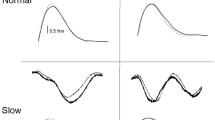Abstract.
Stimulation of cutaneous nerves innervating the hand evokes prominent reflexes in many arm muscles during arm cycling. We hypothesized that the mechanisms controlling reflex modulation during the rhythmic arm swing of walking would be similar to that documented during arm cycling. Thus, we expected cutaneous reflexes to be modulated by position in the walking cycle (phase dependence) and be different when walking compared to contraction while standing (task dependence). Subjects performed static postures similar to those occurring during walking and also walked on a treadmill while the superficial radial nerve was electrically stimulated pseudorandomly throughout the step cycle. EMG was recorded bilaterally from upper limb muscles and kinematic recordings were obtained from the elbow and shoulder joints. Step cycle information was obtained from force-sensing insoles. Analysis was conducted after averaging contingent upon the occurrence of stimulation in the step cycle. Phase-dependent modulation of cutaneous reflexes at early (~50–80 ms) and middle (~80–120 ms) latencies was observed. Coordinated bilateral reflexes were seen in posterior deltoid and triceps brachii muscles. Task dependency was seen in that reflex amplitude was only correlated with background EMG during static contraction (75% of comparisons for both early and middle latency reflexes). During walking, no significant relationship between reflex amplitude and background EMG level was found. The results show that cutaneous reflex modulation during rhythmic upper limb movement is similar to that seen during arm cycling and to that observed in leg muscles during locomotion. These results add to the evidence that, during cyclical movements of the arms and legs, similar neural mechanisms observed only during movement (e.g. central pattern generators) control reflex output.


Similar content being viewed by others
References
Brooke JD, Cheng J, Collins DF, McIlroy WE, Misiaszek JE, Staines WR (1997) Sensori-sensory afferent conditioning with leg movement: gain control in spinal reflex and ascending paths. Prog Neurobiol 51:393–421
Brooke JD, McIlroy WE, Staines WR, Angerilli PA, Peritore GF (1999) Cutaneous reflexes of the human leg during passive movement. J Physiol (Lond) 518:619–628
Brown DA, Kukulka CG (1993) Human flexor reflex modulation during cycling. J Neurophysiol 69:1212–1224
Christensen LO, Petersen N, Andersen JB, Sinkjaer T, Nielsen JB (2000) Evidence for transcortical reflex pathways in the lower limb of man. Prog Neurobiol 62:251–272
Dietz V (2002) Do human bipeds use quadrupedal coordination? Trends Neurosci 25:462
Dietz V, Fouad K, Bastiaanse CM (2001) Neuronal coordination of arm and leg movements during human locomotion. Eur J Neurosci 14:1906–1914
Duysens J, Tax T (1994) Interlimb reflexes during gait in cat and human. In: Swinnen SP, Heuer H, Massion J, Casaer P (eds) Interlimb coordination: neural, dynamical, and cognitive constraints. Academic Press, pp 97–126
Duysens J, Tax AA, Trippel M, Dietz V (1992) Phase-dependent reversal of reflexly induced movements during human gait. Exp Brain Res 90:404–414
Duysens J, Tax AA, Trippel M, Dietz V (1993) Increased amplitude of cutaneous reflexes during human running as compared to standing. Brain Res 613:230–238
Elftman H (1939) The function of the arms in walking. Hum Biol 11:529–535
Fernandez-Ballesteros ML, Buchtal F, Rosenfalck P (1965) The pattern of muscular activity during the arm swing of natural walking. Acta Physiol Scand 63:296–310
Hogue RE (1969) Upper-extremity muscular activity at different cadences and inclines during normal gait. Phys Ther 49:963–972
Jackson KM (1983) Why the upper limbs move during human walking. J Theor Biol 105:311–315
Jackson KM, Joseph J, Wyard SJ (1978) A mathematical model of arm swing during human locomotion. J Biomech 11:277–289
Jackson KM, Joseph J, Wyard SJ (1983) The upper limbs during human walking, part 2: function. Electromyogr Clin Neurophysiol 23:435–446
Komiyama T, Zehr EP, Stein RB (2000) Absence of nerve-specificity in human cutaneous reflexes during standing. Exp Brain Res 133:267–272
Matthews PBC (1986) Observations on the automatic compensation of reflex gain on varying the pre-existing level of motor discharge in man. J Physiol 374:73–90
Van Wezel BM, Ottenhoff FA, Duysens J (1997) Dynamic control of location-specific information in tactile cutaneous reflexes from the foot during human walking. J Neurosci 17:3804–3814
Wannier TMJ, Bastiannse C, Columbo G, Dietz V (2001) Arm to leg coordination in humans during walking, creeping and swimming activities. Exp Brain Res 141:375–379
Zehr EP, Chua R (2000) Modulation of human cutaneous reflexes during rhythmic cyclical arm movement. Exp Brain Res 135:241–250
Zehr EP, Haridas C (2001) Bilateral reflexes in the human upper limbs evoked by electrical stimulation of a cutaneous nerve in the hand during walking. Soc Neurosci Abs 27:305.9
Zehr EP, Kido A (2001) Neural control of rhythmic, cyclical human arm movement: task dependency, nerve specificity and phase modulation of cutaneous reflexes. J Physiol (Lond) 537:1033–1045
Zehr EP, Komiyama T, Stein RB (1997) Cutaneous reflexes during human gait: electromyographic and kinematic responses to electrical stimulation. J Neurophysiol 77:3311–3325
Zehr EP, Stein RB, Komiyama T (1998) Function of sural nerve reflexes during human walking. J Physiol (Lond) 507:305–314
Zehr EP, Hesketh KL, Chua R (2001) Differential regulation of cutaneous and H-reflexes during leg cycling in humans. J Neurophysiol 85:1178–1185
Acknowledgements.
We thank Mr. Alejandro Ley and Mr. Zoltan Kenwell for technical assistance. This work was supported by grants to E.P.Z. from the Natural Sciences and Engineering Research Council of Canada and the Alberta Heritage Foundation for Medical Research. C.H. was supported by a studentship from the Alberta Paraplegic Foundation.
Author information
Authors and Affiliations
Corresponding author
Rights and permissions
About this article
Cite this article
Zehr, E.P., Haridas, C. Modulation of cutaneous reflexes in arm muscles during walking: further evidence of similar control mechanisms for rhythmic human arm and leg movements. Exp Brain Res 149, 260–266 (2003). https://doi.org/10.1007/s00221-003-1377-9
Received:
Accepted:
Published:
Issue Date:
DOI: https://doi.org/10.1007/s00221-003-1377-9




